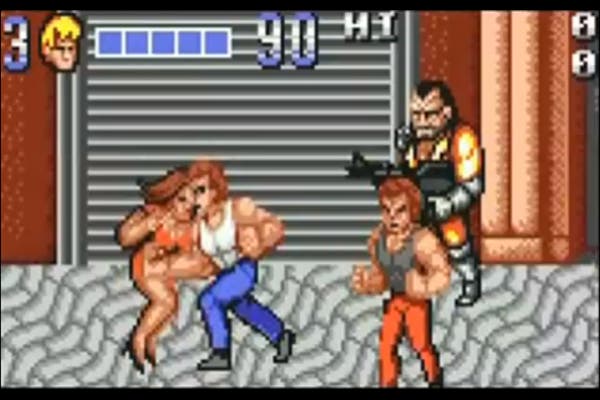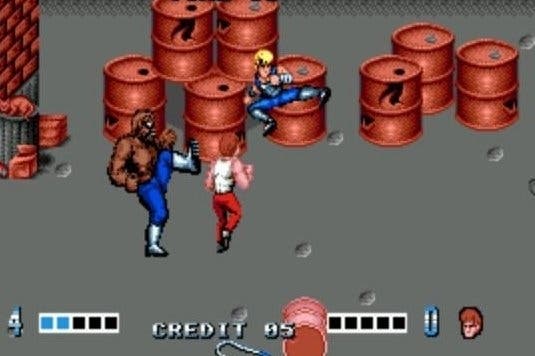Remembering Double Dragon, a true arcade icon
Two's a party.
While not a sport to be advocated, if one were handing out scores for gut-punching strangers Double Dragon would be a straight ten.
In a scene of palpable dramatic tension mini-skirted Marian stands outside Billy and Jimmy Lee's garage, alone on the cooling afternoon tarmac of a breezy city backstreet, the scent of tyres and WD40 hanging on the warm air. Contemplating the volatile love triangle that threatens the very brotherhood of her potential suitors, she's oblivious to the unkempt gang sauntering over, a picture of crudeness, all sweaty vests, blackened sockets and orange boiler suits.
Stinking of gasoline and hard liquor, the soiree gazes on with narcotic eyes and muddy grins as a Tony Manero wannabe strides over. When he's close enough that she can see his dilated pupils and smell the bouquet of gin and nicotine on his odious breath, crack!, he delivers a high-impact three-frame blow into her abdomen, so fierce it rattles the nearby garage shutters. She expels a helium-pitched shriek as the air is forced from her lungs faster than a Roddick serve, before the thug throws her over his shoulder and casually carts her away.

And then the garage door clatters open, and it's time to kick the hell out of someone. Brief but iconic, it's the video game equivalent of Gone with the Wind's finale or Brando's contender. Misogynistic? A simple but effective revenge-driven narrative defined by the limitations of the hardware? Well frankly my dear it doesn't give a damn either way: it's a classic moment in gaming history and that's how it's going to stay.
Although Technos had already revolutionised the beat-em-up with their 1986 arcade game Renegade, its many original conventions going on to become genre standards, it wasn't until the following year that they struck coin-op oil with Double Dragon's altogether more intuitive trial of assault and battery. Introducing fully-fledged scrolling stages with vastly improved graphical detail and fighting mechanics, its two-player simultaneous action, sense of progression, assortment of bosses and the ability to wield various weapons kick-started a scrolling beat-em-up craze that went on to enjoy enormous popularity.
Cultural definitions sharper by design, Double Dragon is a showcase of Reagan era unemployment, a snapshot of 80s ghetto gang warfare: graffiti, flick-knives, permed girls in purple leotards, and immigrant thugs. Twin protagonists Jimmy and Billy Lee are very much of their day: tough youths with ultra-cool Alex Winter hairstyles, matching leather fashions and fully versed in the language of street combat. Sharing an identical attack repertoire, they deal out punch volleys that culminate in jaw-busting uppercuts, kicks to the face that finish with venomous roundhouse whips, and brutal, nose splitting headbutts. Should someone encroach from behind a jumping back-kick or a swift elbow to the ribs - the most powerful move in the game - will take care of business. Infamous, and arguably still the most satisfying grapple in beat-em-up history, you can also ram your knee into the face of offending punks over and over and over.
Yes, before Grand Theft Auto trivialised violence in video games, Double Dragon allowed salarymen and testosterone-fuelled bar patrons to vent their inner aggressor with a gratifyingly excessive knee-into-face routine. Massively damaging and coupled with an effect that sounds like someone hitting a home run, 27 years on and it still doesn't get old. Eventually becoming the series signature move, it no-doubt played a large part in the game's initial appeal.
Although Double Dragon is infamous for slowing to a crawl with as little as four on-screen sprites, the combat remains well-directed with an equitable depth of strategy. You can shrug off enemies that bind you in a headlock, and utilise knives, barrels, chains and baseball bats as effective tools for crowd control. You can't go toe-to-toe with muscle-bound giant Abobo, as he'll end up boxing you to an early grave, and certain enemies won't yield to the old edge-forward-with-kicks-to-initiate-follow-up-grab routine. The elbow is the linchpin of all techniques, a glue that binds one attack to another and can save you in a bind. Technically invincible, it can take out all major enemies, including bosses, albeit in a deliberate and repetitive fashion.
Being just the right length and reasonably soft makes Double Dragon unique in a genre that would go on to milk every coin your parents earned, and for that reason it remains extremely accessible. Collision detection takes a little getting used to and the action often feels like it's underwater: bodies sailing through the air, knives spinning in endless arcs, and baseball bats swinging like they're lead-tipped - but it's an engine chug that adds a satisfying, characteristic weight to the action. The way dudes double over as you slug at their faces, the way they yelp as you kick them down elevator shafts, and the feeling of pinging a couple of heavies with the tip of your bat is all delightfully purgative.

Doubling the strength of Technos' brawl is its oft overlooked audio design. Powerfully effective at enhancing an exchange of fists, the whoosh of weaponry, crack of bones, guttural croak of death, and the slap of someone hitting the pavement make for a cathartic melody of violence. The soundtrack too, is genuinely accomplished, Kazunaka Yamane's hardy opus an unsung classic. From the unforgettable signature theme lighting up the title screen to the toe-tapping rhythms accompanying all four stages, these are the sounds of an era: compositions that rang out in smoky arcades, pool halls, pub lounges and leisure centres for years on end. Hearing them now is a nostalgic trigger for those kids who tiptoed to see the screen, and the teens, primed with a silver coin, who would brush them aside.
Relative simplicity notwithstanding, it's a game that commands a headier sense of drama than most of today's cutscene stuffed multi-million dollar templates. With an unruly kidnapping to avenge, fighting your way tooth and nail through streets, factories, deep forest, mountain paths, and into the trap-laden lair of the Black Warrior gang remains distinctly stirring. Dicing with wall-busting hulks, avoiding being batted into lakes, and trying to force that green guy at the end of stage two into death by conveyor belt are but a handful of exciting nuances in an altogether well-rounded adventure. And of course one of video gaming's all-time great twists awaits two successful players: the final one-on-one scrap for Marian's affections, brother against brother in a no-holds-barred fight to the death set against no-continue stakes. Only one could win the limelight and enjoy the culmination of all those frittered away ten-pence pieces; and no matter who you were partnered with - friend, sibling, stranger - the adrenaline spike as you suddenly went from incorruptible kinship to fratricidal malice was positively profound.
As the 80s drew to a close, Technos sought to establish itself with a game that, for its time, had a prominent, easily identifiable narrative to validate its breakthrough beat-em-up format. To those who discovered it during an age of burgeoning creativity, where new thrills always seemed just around the corner, it's an icon of arcade lore, and justly so.









